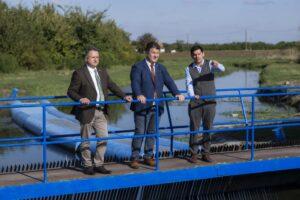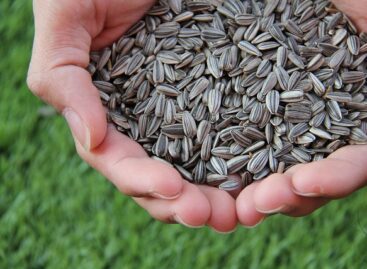Farmers in the Great Plain can be helped by increasing water reserves stored in the landscape
The Great Plain was affected by the greatest water loss, with more than a third of the drought damage reported from here. Farmers in the Great Plain can be helped most by increasing water reserves stored in the landscape, said the State Secretary for Agriculture of the Ministry of Agriculture in Battonya, Békés County, on Tuesday.

(Photo: AM/Csaba Pelsőczy)
Imre Hubai said at a press conference at the Battonya pumping station during a site visit after the filling of the so-called Dry-Vessel that more than one billion cubic meters of water have already been stored nationwide thanks to the Water in the Landscape program. More than 300 interventions have been carried out, and the government has provided 4.7 billion forints of funds for the program, on which more than a thousand people have worked so far. In response to MTI’s question, he added that in Békés County, from the Bihar part to the Maros alluvial fan, almost 30 interventions have taken place, and farmers have also offered – typically lower-lying areas – for flooding. He emphasized that 400 thousand cubic meters of water were filled in the so-called Koplaló backwater in the county, and the resulting increased evaporation also contributed to local precipitation. They hope for this elsewhere as well, along with the fact that they will succeed in “rewetting the soils of the Great Plain”. The state secretary said that they are experiencing that groundwater has been “lost”: a 2, or rather 3-meter water level drop has occurred on 81 thousand square kilometers; the lack of water is already endangering the fertility of the soil. In order to restore and preserve the competitiveness of agriculture, plans and reservoirs are also needed to make the water supply safer, he added.
Imre Hubai indicated that they plan to announce a new support scheme that will reward water retention
This way, former wetlands can be restored in weaker production areas; and by replenishing groundwater resources, the resilience of agriculture will improve. According to the state secretary, they plan to assess the so-called tertiary waterworks and sewer networks within the borders of settlements by the end of November; by the beginning of January, technical plans would be prepared for the repair of up to several thousand kilometers of sewers, and in February, they would “support” the financial needs for this. Norbert Erdős (Fidesz), the MP for the region, emphasized that there has never been an example of Hungary buying water from Romania not for irrigation but for water retention, but this happened in the case of the Száraz-ér. He explained that the missing water was replenished from two directions in the approximately 70-kilometer-long Száraz-ér: one million cubic meters were purchased from Romania for 40-44 million forints, and 600 thousand have already “come down”; and from the Maros, nearly 25 thousand cubic meters of fresh water arrived in the vessel in the Földeák area. 54 million forints were earmarked for the investment. The National Directorate General of Water Resources has also allocated 30 million forints for the cleaning and rehabilitation technical planning of the Száraz-ér, which has begun, he added. Norbert Erdős said that the country’s best-quality lands, 43-45 golden-crowned farmlands, are here, but the region has been suffering from a water shortage since 2022. Norbert Farkas (independent), mayor of Mezőkovácsháza, said at the press conference that the Száraz-ér affects Battonya, Mezőkovácsháza, Tótkomlós and Végegyháza. These settlements plan to establish a joint association, cooperating with the Aldó-Tisza-vidéki Water Directorate on water issues.
AM/MTI
Related news
European Commission to strengthen checks on agricultural products entering the EU
🎧 Hallgasd a cikket: Lejátszás Szünet Folytatás Leállítás Nyelv: Auto…
Read more >Sunflower and rapeseed seed prices have decreased
🎧 Hallgasd a cikket: Lejátszás Szünet Folytatás Leállítás Nyelv: Auto…
Read more >Farmers can count on the government in the fight against drought
🎧 Hallgasd a cikket: Lejátszás Szünet Folytatás Leállítás Nyelv: Auto…
Read more >Related news
The HORECA sector joins forces with Alimentaria+Hostelco to mark the future of hospitality
🎧 Hallgasd a cikket: Lejátszás Szünet Folytatás Leállítás Nyelv: Auto…
Read more >Challenges of the retail sector: retail has become more crisis-resistant
🎧 Hallgasd a cikket: Lejátszás Szünet Folytatás Leállítás Nyelv: Auto…
Read more >How to avoid the hassles of online shopping?
🎧 Hallgasd a cikket: Lejátszás Szünet Folytatás Leállítás Nyelv: Auto…
Read more >






